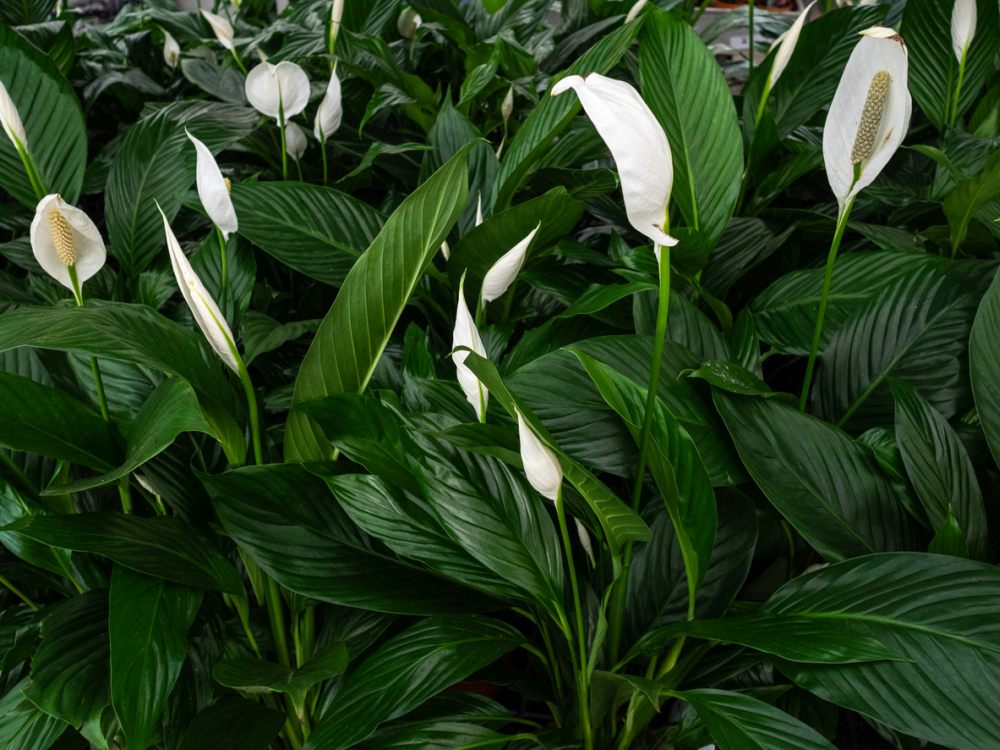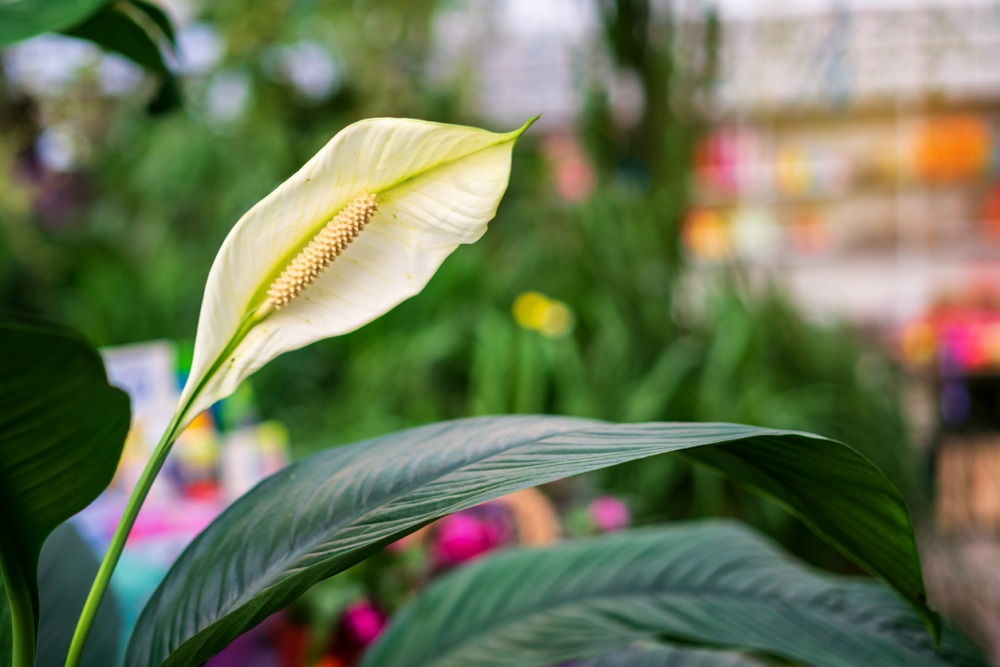Peace Lilies – How To Grow And Care For Spathiphyllum
Considered to be one of the most auspicious plants to bring you luck and good fortunes, peace lilies are a common fixture of many gardens and households. Apart from being exquisitely beautiful, these evergreen plants with their white flowers are excellent air purifiers. The plant absorbs toxins, exhaust fumes, and formaldehyde from the air so well, it is featured on NASA’s list of the top plants to grow in space stations.
With all these advantages, who wouldn’t want to grow peace lilies indoors or outdoors? And did we mention that they are easy to grow? The only drawback is the plant’s toxicity to animals. We’ll cover that in more detail later. But first, let’s get up close and personal to the peace lily and find out more about what makes it popular and how to grow one yourself.
Peace Lilies at a Glance
In their natural habitat, peace lilies (Spathiphyllum) grow in the shadow of large trees in tropical forests. Not only are these evergreen plants, but they can also bloom more than once throughout the year in the right conditions. And what unique flowers this peace lily has.
Not really related to the lily family, peace lilies are members of the Araceae family and average between 16 inches to 6 feet high depending on the variety. So you can grow it as a houseplant or plant it in a small corner in your garden or backyard. But since it has USDA hardiness zones between 10 and 11 requiring warm temperatures and high levels of humidity, it’s only suitable for outdoor growing in Florida and Southern California.
Native to South America, the peace lily is also known as the white sail plant, spathe, and white flag. The reason has to do with the shape of the flower. Each flower has a single white or off-white petal that stands up like a sail. It starts to bloom in the early summer and, with proper care, you might get another flowering cycle in the fall. Each bloom cycle lasts for a couple of months.
Peace Lilies Varieties
Peace lilies have about 40 natural species and more than double that number in cultivars. To simplify things, we can classify peace lilies by size. You have small species, medium lilies, and large cultivars. Both small and medium lilies are more suitable as houseplants while large cultivars are for outdoor growing. Here are the top varieties to consider.
- Power Petite: A small variety that doesn’t grow an inch above 15 inches. It has large, veined, and deep green leaves along with the trademark off-white sail-like flowers. It is easy to grow and you can keep it in a small pot on a window sill with a thin curtain drawn to protect it from the garish rays of the sun.
- Wallisii: This variety is similar to Power Petite in every aspect except for the leaves. The leaves here are more elongated and rippled and the foliage is less dense. But both varieties have the same size and are ideal for indoor growing.
- Mauna Loa Supreme: An ideal name for a plant that reaches 4 feet tall. The flowers have a pinkish tint and the broad leaves are about 9 inches wide. It has fewer blooms on average than other varieties but the highly ornamental green foliage is stunning.
- Clevelandii: Another medium variety that attributes its popularity to its leaves rather than the flowers. The average plant grows between one to three feet high and the leaves are about one and a half feet tall.
- Sensation: This variety belongs to the giants of the species. Nothing says tropical garden like having the 20-foot Sensation splaying its broad 20-inch long leaves every other way. If that’s too large for your taste, why not try the smaller version called the ‘Sensation Mini’? It has all the great features of the variety but in a more compact and manageable size.
- Domino: Not exactly a giant variety, but this one stands out with its variegated leaves. The leaves are bright green with splashes of white all over them. A wonderful variety that brings beauty to your living room while purifying the air you breathe.
How to Grow Peace Lily
Whether you prefer to grow peace lilies in a container or as an outdoor plant depends on the weather conditions in your area. We recommend that you try it as a houseplant to get the most out of its air-purifying abilities. You can also do away with soil altogether and grow it in a vase full of nothing but water. It doesn’t get any easier than that. Here’s how to grow it as a potted plant in easy steps.
- Select a plastic or terracotta container one and a half times larger than the rootball of the peace lily. Make sure it has a lot of drainage holes at the bottom.
- Fill the pot halfway with a general-purpose potting mix. Don’t add organic material or compost to the mix.
- Inspect the rootball of the peace lily and remove any rotten or damaged roots.
- Dig a hole in the middle of the pot a couple of inches deeper than the height of the rootball.
- Place the plant in the hole so that the top of the rootball is at least one inch below the surface of the soil.
- Fill the hole with soil and pack it to eliminate any air pockets from around the root system.
- Water the plant immediately to help the soil settle and allow the roots to absorb the moisture and nutrients in the fresh soil.
- Move the pot to the window sill where it can get the dappled sunlight it prefers. If the sun is too harsh, draw a thin or lace curtain across the window.
Another way to grow peace lilies is to use water instead of soil. Just remember to change the water regularly and use mild liquid fertilizer high in phosphorus and low in nitrogen.
Peace Lilies Care
And that’s all it takes to get a peace lily started in your home. As for its care, this evergreen plant is very low maintenance. Even watering which is often the trickiest part of maintaining many garden plants isn’t a problem here since the plant thrives in water the same way it grows well in soil.
Light
It’s not the soil or water that should be the top of your priority when caring for peace lilies, but the lighting conditions. Too much light can cause the leaves to turn yellow and might stop the plant from flowering altogether. As a rule of thumb, you should mimic the light conditions of its original habitat on the floors of tropical rainforests. The light that reaches the lilies in the wild is often filtered and dappled. So Use a lace curtain to cut the brightness of the sunlight. Some varieties can grow well in dim-lit rooms and offices. However, the majority require sunlight to bloom at least once every spring.
Flowering
Yes, flowering, or the lack thereof, is a common issue with peace lilies grown as houseplants. Many people complain that the plant is not flowering at all. Others say that the flowers are either green or look sickly. To encourage your peace lily to bloom every year, you should provide it with enough light. Move the pot to a window sill that gets the afternoon sun and filter that light with a thin curtain. Using the wrong fertilizer can also prevent the plants from flowering or cause the blooms to look green and sickly. Avoid fertilizers high in nitrogen and use, instead, a custom fertilizer high in phosphorus. If you’re not sure what type of fertilizer you have, cut off fertilizing altogether. The lilies will bloom well without the need for plant food supplements.
Water
As we mentioned, peace lilies are not afraid to dip their roots in water and keep them there. The plants grow well in any medium, be it soil or water. When you keep it in a vase full of water, remember to change the water every couple of days to prevent fungal infections and the spread of diseases in the stagnant water. If you grow it in soil, then keep the soil moist without overwatering. Either way, you should refrain from using tap water since the chemicals would damage the leaves. Instead, you should use filtered room-temperature water for irrigation.
Pests and Diseases
Aphids and mealybugs have developed a taste for the sap in the leaves of the peace lilies. Once they move in, they’re hard to get rid of. Apply neem oil to eliminate these pests. If you don’t have neem oil, then dip a swab in rubbing alcohol and give the leaves a good rub.
As for diseases, the most two common ones are yellow leaves and brown leave tips. Yellow leaves are the result of drought, overwatering, or light deprivation. Water your plants regularly to keep the soil moist and if they’re in a dim-lit place, move them to the window. Remove the yellow leaves to trigger the plant to replace them with lush green ones.
Brown leaf tips and edges are either related to inadequate light conditions or low humidity levels. If the room is poorly lit, move the pot to the window. If you still get brown leaf tips, try misting the plant a couple of times a week.
The Toxicity of the Peace Lily
Peace lilies are mildly toxic to humans but highly toxic to animals. Cats, in particular, can get severe symptoms if they ingest any part of the peace lily. The leaves of the plant contain calcium oxalate crystals which irritate the mouth of the cat or dog. Since pets are curious by nature, you should keep your peace lily away from their reach. Symptoms of severe poisoning include excessive salivation, shaking their heads, and pawing the floor repeatedly. You should take your pet to the vet immediately for medical attention.
Likewise, the plant is toxic to small children. Unlike pets, a child might not stop eating the peace lily after the first bite. You should seek medical help if your child ingests any part of the plant.

